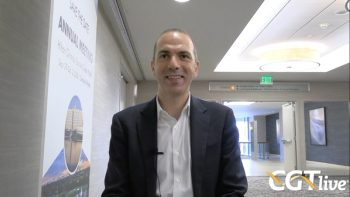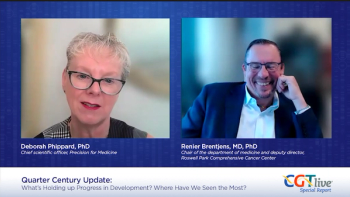
Stem Cell Stroke Therapy Demonstrates Safety in Treatment of Ischemic Stroke
Clinically relevant scores of 32 and 44 on the Fugl-Meyer Motor Score were documented in 2 patients who received NSI-566.
Recently released results from Senena Biopharma’s phase 2 stroke study using the company’s human neural stem cell therapy, NSI-566, demonstrated a safe profile and may have utility as a treatment for paralysis and stable deficits in motor function caused by ischemic stroke.1
The Chinese-based study enrolled 23 patients who were randomly assigned to treatment or placebo arms. By the end of the study period, 3 serious adverse events (SAEs) that were considered to be probably or possibly related to treatment were documented in the treatment arm, whereas no patients in the placebo arm experienced SAEs.
Treatment-related SAEs were resolved with standard medical care and included impaired healing at the incision site and would dehiscence in 1 patient, and impaired hepatic function in another.
"Stroke is the leading cause of death and disability in China,” Ruxiang Xu, former president, BaYi Brain Hospital, and study principal investigator, said in a statement. “Results from this study show NSI-566 may have utility as a treatment for paralysis and motor deficits caused by ischemic stroke.”
Those included in the treatment arm received intracerebral injection of 72 million stem cells, whereas those in the placebo group underwent a sham surgery procedure. Researchers evaluated the efficacy of NSI-566 by using the Fugl-Meyer Motor Score (FMMS), an assessment of upper and lower motor function that comprises a 100-point scale and has been used as a standard following stroke.
READ MORE:
After 1 year, the mean improvement was greater in those participants receiving NSI-566 (n = 10; mean standard deviation [SD], 12.20 [±14.15]) compared to placebo (n = 10; SD, 6.30 [±5.14]), despite most participants showing some sort of improvement in FMMS from pre-surgery scores. Researchers concluded the difference between the treatment arms did not reach statistical significance using the approximate Student’s t-test (MMRM; P = .231).
It was noted that there were 2 participants who received NSI-566 that showed clinically important improvements of 32 and 44 points on the FMMS following treatment, whereas the largest improvement observed in the placebo group was 17 points.
"Additional larger studies will be critical in demonstrating the clinical potential of NSI-566 in this unmet need,” Xu added.
In July 2019, the company announced results from their open-label phase 1 clinical trial. Entitled, “Stable Intracerebral Transplantation of Neural Stem Cells for the Treatment of Paralysis Due to Ischemic Stroke, the manuscript showed that the treatment was well tolerated at all doses and subjects showed stable increased in FMMS from baseline, indicating the procedure is safe and may provide benefit to treat motor deficits caused by stroke.2
Each of the subjects included in the phase 1 trial had sustained chronic motor deficits due to ischemic stroke 5 to 24 months prior to enrollment and were divided into 3 cohorts receiving intracerebral injections of NSI-566 cells totaling 12, 24, or 72 million cells.
At the 12-month visit, the mean FMMS for the 9 participants showed 16 points of improvement (P = .0078), the mean modified Rankin Scale (mRS) showed 0.8 points of improvement, and the mean National Institutes of Health Stroke Scale showed 3.1 points of improvement (P = .020).3
Using stem cells as a form of treating stroke and stroke associated symptoms has been documented before. Creative Medical Technology recently filed an
ImmCelz uses stem cells outside of the body to “reprogram” the patient’s own immune cells to endow upon the immune cells’ regenerative activities, whereas other stem cell-based approached use significantly smaller immune cells aimed at penetrating areas of the damaged brain and induce regeneration.4
REFERENCES
1. Seneca Biopharma announces top line data from phase 2 clinical study in China for the treatment of ischemic stroke. News release. January 20, 2021. Accessed January 28, 2021. https://www.prnewswire.com/news-releases/seneca-biopharma-inc-announces-top-line-data-from-phase-2-clinical-study-in-china-for-the-treatment-of-ischemic-stroke-301211384.html
2. Neuralstem announces publication of results from phase 1 clinical trial evaluating human neural stem cells in chronic stroke patients. News release. July 1, 2019. Accessed January 28, 2021. https://senecabio.com/news-media/press-releases/detail/264/neuralstem-announces-publication-of-results-from-phase-1.html
3. Zhang G, Li Y, Reuss JL, et al. Stable intracerebral transplantation of neural stem cells for the treatment of paralysis due to ischemic stroke. Stem Cells Transl Med. Published online June 26, 2019. doi: 10.1002/sctm.18-0220
4. Creative Medical Technology Holdings files investigational new drug application (IND) with FDA for treatment of stroke using ImmCelz regenerative immunotherapy. News release. Creative Medical Technology Holdings. January 12, 2021. Accessed January 28, 2021. https://www.prnewswire.com/news-releases/creative-medical-technology-holdings-files-investigational-new-drug-application-ind-with-fda-for-treatment-of-stroke-using-immcelz-regenerative-immunotherapy-301206267.html
Newsletter
Stay at the forefront of cutting-edge science with CGT—your direct line to expert insights, breakthrough data, and real-time coverage of the latest advancements in cell and gene therapy.










































